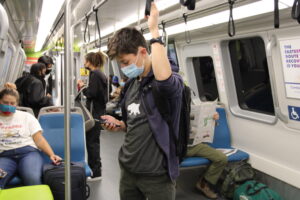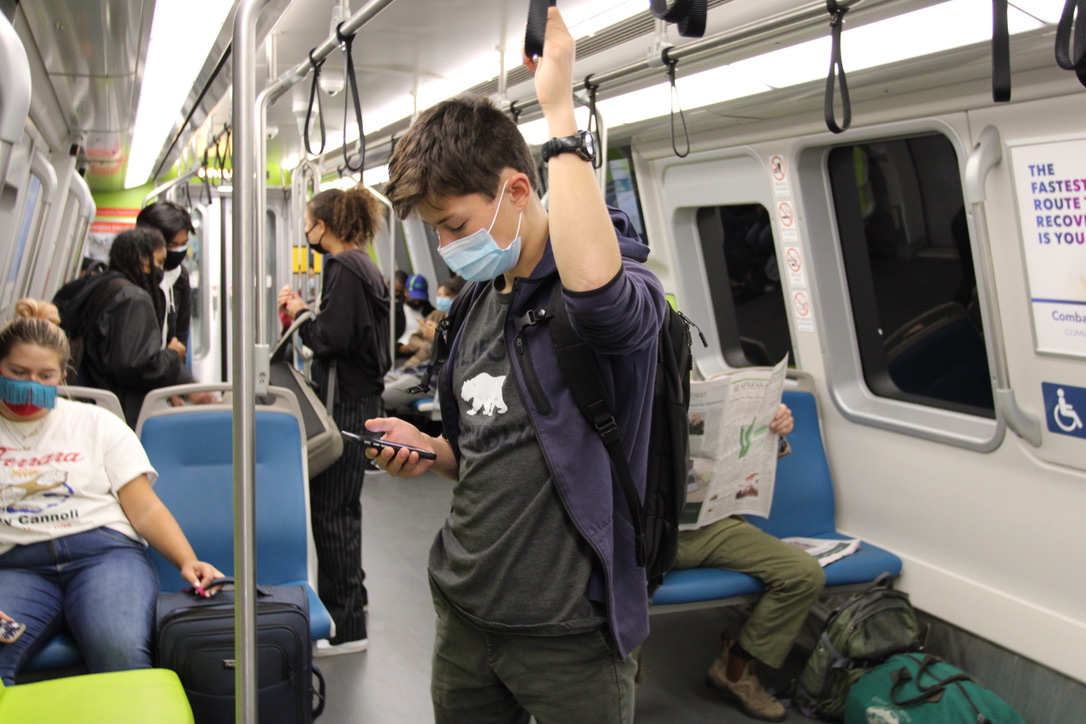Lick-Wilmerding Senior Kate Peterson ’22 spends upwards of two hours each day getting to and from school, yet has turned this slogging commute from Marin to San Francisco into a time for solace.
Peterson learned to search for beauty in the mundanities of everyday life. “I like to watch out the windows, what’s going on around me…I try not to think about school too much because that makes me feel very anxious.” Instead of sinking into taxing thoughts, she found something that excites her: “I’ll see the same people at the bus stops every day…and I’m like oh! It’s that person I see every single day! It’s funny because the bus driver knows which buses people get on,” said Peterson.
The return to high school on campus reintroduces a daily commute for LWHS faculty and students— another time commitment in our already packed lives. Will the added stress of commute time intensify grind culture or does it present an opportunity for change?

photo by Anabel Harris
Articles in Business Insider, Psychology Today and the New York Times explore the hidden cost of commuting and its harm on psychological, cardiovascular and social health.
When there is always something to do (the incessant juggle of sleep schedules, homework and socializing), commuting might eliminate the possibility of “me-time”. Yet LWHS community members do not think commutes have to be so stressful: self care can happen in a variety of settings.
Erin Merk, a Zen priest who teaches yoga, mindfulness and health at LWHS extols using movement as a stress reliever— it deliberately transforms her commute into a healing practice. “I’m lucky because I can choose from a lot of different ways to get here. I can include a walk in my commute, which I find incredibly nourishing. It’s so nice to be able to move my body and release stress. Or I can ride my bike. Exercise so clearly impacts my mood.”
LWHS Counselor, Yuka Hachiuma also promotes healing practices. “The trick is finding what works for you. You have this discrete amount of time where you can’t do other things. So how do you want to use it to feel calm or relaxed?” said Hachiuma. Commuters have the option to remove self judgement and ask themselves: How do I feel, and what might bring me joy at this moment?
Peterson’s commute from Marin to school each day begins with a drive to the bus stop. She then rides the bus from Pacific Heights to Ocean Ave. Peterson described her typical morning, “By the time I get to school I’m ready to be here, because I always listen to music or an audiobook on the bus, which is really meditative. It’s nice to have that break before getting to school because there’s no rush about it.” The stress-free time Peterson recounted is one of many practices to potentially boost her well-being.
An additional stressor commuters experience is the thought that they are losing an hour each day to commute time, resulting in a lack of “productivity” and self criticism. “Lost time” is especially hard on adults who drive alone, as they rush to and from work. “You kind of feel powerless in a car stuck in traffic when you have to make dinner and be home by a certain time,” said Hachiuma. Concentrating on the road for a long stretch of time can be draining, especially when sedentary and without company— those on public transport have more flexibility.
LWHS Counselor Erika Solís helps dismantle the idea that commutes take away from productive work time. “We’re all under such cultural pressure to be productive all the time: that if we’re awake then we should be productive,’’ said Solís. This stigma creates an unrealistic expectation for us. “What’s productive in terms of protecting and enhancing your mental health might not look like doing work, but engaging in other things that bring you joy,” said Hachiuma.
LWHS students are familiar with the pressure to sustain a perfect G.P.A., but Solís emphasizes something more important: “Validating that people are tired and carry a lot of burdens. We’re not saying that this (the way you use your commute time) will transform your life. But how can you use that little space in a way that will contribute towards your well-being?” said Solís.
Although self care is beneficial, it is not a solution to serious mental health challenges. “Self-care works really well when you’re in the healthy stress realm. As you start getting into unhealthy stress, self care alone is not going to do it. Try these things, but if you feel like it’s not getting the relief, seek out support from a trusted adult,” said Solís.
LWHS Learning Strategies Coordinator Owen Dempsey worked with Hachiuma to create Weekly Wellness meetings last year, which informed students of helpful coping mechanisms for stress and long term wellbeing strategies. These presentations are accessible on the LWHS Blackbaud Resource Board under “Wellness”.
Those looking to try these practices might also benefit from mindfulness and breathing apps. “If someone is feeling like ‘I don’t really know what to do, but I know I don’t feel very good right now’, an app or something more guided might be really helpful,” Solís said. Solís also proposed watching nostalgic videos online, like a video or movie from one’s childhood. “On Netflix, there are headspace videos that are really cute and pretty short. It guides you through an exercise, so see if that’s something helpful,” said Hachiuma.







